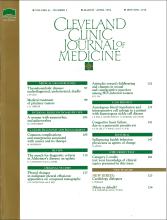ABSTRACT
BACKGROUND Although the pathologic findings in Alzheimer’s disease are well documented, definitive diagnostic criteria are lacking.
OBJECTIVE To review the histopathologic findings in Alzheimer’s disease.
SUMMARY In Alzheimer’s disease, the brain may be normal in size or atrophic. There is selective neuronal loss associated with neurofibrillary tangles and senile plaques with amyloid deposits. Amyloid protein may also be deposited within arterioles. There may be granulovacuolar degeneration and Hirano bodies in the hippocampus. Two diagnostic schemes have been proposed based on the presence of senile plaques, but neither is entirely satisfactory.
CONCLUSIONS The pathologic diagnosis is usually made in conjunction with the clinical history. Probably, neither definitive diagnostic criteria nor effective treatment for Alzheimer’s disease will be possible until we understand more about its etiology. Clinicians should attempt to rule out other, potentially curable causes of dementia in elderly patients such as trauma, depression, metabolic abnormalities, infection, vascular disease, and other central nervous system diseases.
- Copyright © 1994 The Cleveland Clinic Foundation. All Rights Reserved.






